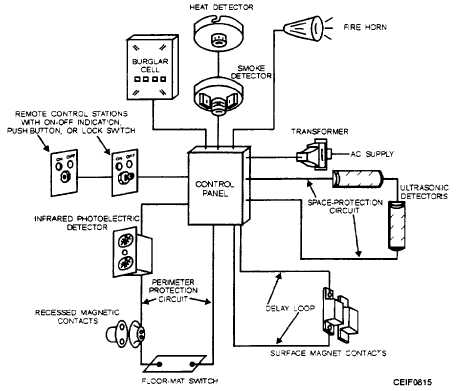Some of the various components for a typical security/fire-alarm system are shown in figure 8-15.
CONTROL PANEL
This is the heart of any security system. It is the circuitry in these control panels that senses a broken contact and then either sounds a local bell or horn or omits the bell for a silent alarm. Most modem control panels use relay type of controls to sense the protective circuits and regulate the output for alarm-sounding devices. They also contain contacts to actuate other deterrents or reporting devices and a silent holdup alarm with dialer or police-connected reporting mechanism.
The control unit also continuously. monitors the condition of the alarm-initiating-and-indicating- circuit wiring and provides a trouble indication in the event of an abnormal condition in the system, such as an ac power failure or a wiring failure.
The control unit is usually housed in a sheet-metal cabinet (fig. 8-16). The control unit usually provides annunciation of signals (telling where a signal originates).
Because all circuits end at the control unit, it is a convenient test location. Test switches (if provided) are usually inside the locked door of the control unit. If the switches are key-operated, they may be on the control unit cover, rather than inside the cabinet.
POWER SUPPLIES
Power supplies vary for different systems; but, in general, they consist of rechargeable 6-Vdc power supplies for burglar-alarm systems. The power packs usually contain nickel-cadmium batteries that are kept charged by 12-Vac input from a plug-in or otherwise connected transformer to a 120-volt circuit. Better power supplies have the capability of operating an armed system for 48 hours or more without being charged and still have the capacity to ring an alarm bell for 30 minutes or longer. Power supplies are obviously used in conjunction with a charging source and supply power for operation of the alarm system through the control panel.
Many older local alarm systems are powered by alternating current (ac) power only with no provision for standby, battery power. In these cases, two separate ac circuits (usually 120/240 Vac) are used: one to power the fire-alarm system operating circuits and another to power the trouble-signaling circuits of the system. Low-voltage alarm systems, especially, those provided with battery standby power. are most often

Figure 8-15. - Various components for a typical security/fire-alarm system.
Continue Reading